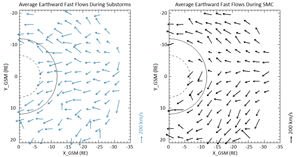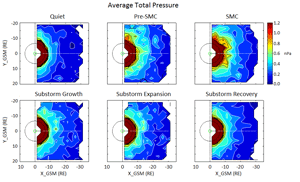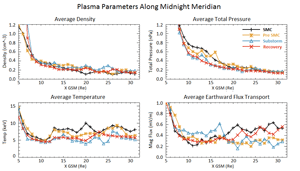
2012 THEMIS SCIENCE NUGGETS
Diversion of plasma due to high pressure in the inner magnetosphere during steady magnetospheric convection
by Jenni Kissinger, NASA GSFC
Introduction
Space weather consists of the Earth's magnetic field, or magnetosphere, reacting to the solar wind output from the Sun. The Sun's magnetic field can sometimes 'reconnect' with the Earth's magnetic field, allowing plasma and energy to enter our magnetosphere. This reconnection on the dayside in turn results in reconnection on the nightside of the Earth, in the magnetotail. If the reconnection rates between the dayside and the nightside are unbalanced, a substorm will occur. A substorm is when energy builds up in the magnetosphere and is then quickly and powerfully released, similar to a thunderstorm. If the reconnection rates are balanced instead, the magnetosphere experiences steady magnetospheric convection, or SMC. SMC events last for hours, and are analogous to a constant steady rain.
During a substorm, which is the more common response of the magnetosphere, plasma and energy (or "flux") is reconnected in the magnetotail and then 'piles up' near the Earth in the inner magnetosphere. In order to maintain balanced reconnection during an SMC event, however, flux from the nightside needs to return to the dayside to reconnect with the solar wind once more. How does the magnetosphere return this flux and maintain a stable, enhanced configuration, for hours at a time? We used the five THEMIS spacecraft to help answer this question.
Results: Fast Flows
The first figure shows a view of fast flows in the magnetotail, in the GSM x-y plane. Fast Earthward flows (equatorial speed greater than 200 km/s, positive Vx component) were averaged together in bins of 3 by 3 Earth radii (RE). The left panel shows flows that occur during substorm expansions, and the right panel shows flows during SMC events. In general, the SMC flows display a pattern of deflection (i.e., larger Vy component). Closer to Earth and away from midnight, flow vectors point more toward the dawn and dusk flanks. For the substorm case, flows are more directed toward the Earth (small Vy component).
Additionally, the occurrence of fast flows differs. Overall, more fast flows occur during SMC than during substorms, and the SMC fast flows transport more flux. This is especially true at farther distances from the Earth (from 20 to 30 RE). However, the opposite is true closer to the Earth: within 15 RE, fewer fast flows occur during SMC compared to substorms. Therefore, fast flows in the tail are not reaching into the inner magnetosphere during SMC as they do during substorms, and are instead diverted toward the dawn and dusk flanks of the tail.
| Figure 1. Average fast Earthward flow vectors during (left) substorm expansions and (right) SMCs. Flows were averaged into 3 x 3 RE bins and are plotted in the GSM x-y plane. The dashed semicircle represents geosynchronous orbit (6.6 RE) and the solid semicircle represents the apogee of the THEMIS D and E spacecraft (11.9 RE). Flows are scaled to 200 km/s (right arrow key). |
Results: Pressure
What could cause such a deflection? Figure 2 shows the average total pressure in the GSM x-y by different types of activity. Quiet (top left) means little to no tail convection (or reconnection). SMC events are shown on the top right, and the top middle panel shows Pre-SMC, or the two hour interval before SMC events begin. The bottom three panels show the three stages of isolated substorm: growth (buildup of energy, beginning of reconnection), expansion (release of energy, enhanced tail reconnection and convection), and recovery (magnetosphere returns to quiet state). Most SMCs are preceded by a substorm expansion, so the Pre-SMC panel can be compared to the substorm expansion panel.
| Figure 2. Contour maps of average total pressure in the X-Y GSM plane by type of activity: (top) quiet, pre-SMC, and SMC and (bottom) substorm growth, expansion, and recovery. All plots are to the same color scale. |
At first glance all the panels seem similar: high pressure close to the Earth in the inner magnetosphere (dark red), and lower pressure farther from the Earth in the tail (dark blue). However, the inner high pressure region for SMC events is broader compared to the other modes. The gradient (or transition between dark red and blue colors) is sharper (occurs over smaller distance) for substorms compared to SMC. Additionally, the pressure during Pre-SMC is closer to the SMC case than the substorm case. This shows that the substorms that precede SMC are different from 'typical' or isolated substorms, and that they help precondition the magnetosphere toward SMC events.
| Figure 3. Average plasma parameters along the midnight meridian (within |Y| < 5 RE): (top left) density, (top right) total pressure, (bottom left) temperature, and (bottom right) Earthward magnetic flux transport. Four types of activity are shown: substorm expansion (blue), substorm recovery (red), Pre-SMC (orange), and SMC (black). |
In addition to being broader, the inner region total pressure during SMCs is higher compared to substorms. Figure 3 shows averages of density, total pressure, temperature, and flux transport vs. distance from the Earth, with values taken along the midnight meridian. The pressure during SMCs (black line) is larger compared to the Pre-SMC interval and substorms. It remains larger out to beyond 15 RE.
A fast flow from Figure 1, moving Earthward during a substorm, will move inward until it encounters the sharp pressure gradient. It will slow and the flux it carries will 'pile up'. A fast Earthward flow during an SMC, however, will encounter this broad region of higher pressure farther from the Earth, with a more gradual gradient. Inside of being slowed, it is deflected either dawnward or duskward. The flux it carries is transported around the Earth and back to the dayside.
Conclusion
We found that the magnetosphere can maintain balanced reconnection during SMC through the following:
1. Nightside reconnection in the midtail (beyond 30 Earth radii) generates many fast flows, carrying enhanced magnetic flux. Fast flows are deflected away from the inner magnetosphere 'pile-up region', towards the dawn and dusk flanks, and return flux to the dayside.
2. This diversion is due to a broad region of high pressure in the inner magnetosphere, extending out beyond 15 Earth radii.
3. The high pressure region is formed before the SMC, during a substorm onset that precedes the event.
4. Substorms that transition to SMC differ in solar wind driving conditions and magnetospheric plasma properties, compared to isolated substorms.
Reference
Kissinger, J., R. L. McPherron, T.-S. Hsu, and V. Angelopoulos (2012), Diversion of plasma due to high pressure in the inner magnetosphere during steady magnetospheric convection, J. Geophys. Res., 117, A05206, doi:10.1029/2012JA017579.Biographical Note
Jenni Kissinger is a postdoctoral fellow at the NASA Goddard Space Flight Center. She uses statistical data analysis from missions including THEMIS, SAMPEX, and the Van Allen Probes to determine how the mode of magnetospheric response affects the plasma sheet, inner magnetosphere, and energization of particles.
 Please send comments/suggestions to
Emmanuel Masongsong / emasongsong @ igpp.ucla.edu
Please send comments/suggestions to
Emmanuel Masongsong / emasongsong @ igpp.ucla.edu



